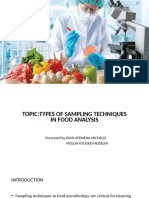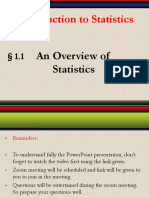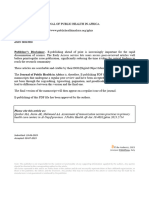6) Sampling Methods (I-5)
Uploaded by
Vasudeva Prasad Nemala6) Sampling Methods (I-5)
Uploaded by
Vasudeva Prasad Nemala6) Sampling Methods (I-5)
The ultimate responsibility of the analyst is to determine the acceptability or unacceptability of a given lot or shipment of food material based upon his or her examination. For reasons of time and cost, it is clearly impractical for the analyst to examine every item in a shipment or lot. Thus the analyst must limit detailed examination of material to a sample collected from the lot. Since decisions about regulatory action are therefore necessarily made by extrapolation, it is important that sampling techniques used by inspectors are consistent with statistical theory. Two sampling techniques, representative and selective sampling, are used in conjunction with the methods in Chapter V. These are discussed below. a. Representative Sampling -- Representative sampling is an objective sampling technique used when the sample of the material has been selected to maximize the probability that it contains the same proportion of defects as the entire lot. That is, the analyst wishes to make a determination about the condition of the entire lot. To assure this, a representative sample must always be drawn by using random selection. Random selection or sampling is sampling from a population such that each element is the population has an equal probability of being selected for inclusion in the sample. Another important element in representative sampling is size. The larger the sample size, the higher the probability that the representative sample contains the same proportion of defects as the entire lot. If perfect certainty were required, clearly the entire lot should be sampled. Statistical theory allows the analyst to work with relatively small representative samples while maintaining quite high levels of certainty that determinations made on the basis of the examination of a sample are accurate reflections of the condition of the entire lot. As an example of the power of statistical inference, consider the accuracy of prediction about Presidential election results. These projections are usually accurate to within a few percentage points but are based on samples of only a few thousand voters. When the analyst uses methods in this manual, questions of sample size and levels of certainty have been resolved in advance by agency statisticians applying the concepts of acceptance sampling. Decision rules about when to accept or reject an entire lot have been incorporated into the methods in Chapter V. Sampling plans called for in the manual are specified at the beginning of each procedure. The plan usually calls for a fixed sample size. Some procedures allow the analyst to examine the material in an iterative fashion using a sequential sampling plan. For sequential sampling, the decision rules indicating when to accept, reject, or continue sampling are built into the plan. For fixed sampling plans, the "Report" section of the procedure indicates when to accept or reject a lot. In some instances the lot sample itself may be so large that the analyst cannot effectively examine the entire sample. In this situation, unless evidence of defects dictates that the entire sample should be analyzed, an analytical sample must be taken by the
analyst for examination. The analyst's responsibility here is to ensure that the analytical sample is representative of the lot sample. The sample preparation section of each procedure provides guidance as appropriate. (For example, in Chapter V Section 3.A, the procedure for determination of insect-damaged wheat kernels calls for use of a Jones sampler or Boerner divider to reduce the size of the lot samples to representative analytical units.) b. Selective Sampling -- Selective sampling is a subjective sampling technique where materials are drawn to confirm a suspected defect. Unlike representative sampling where material is drawn at random to assess the general condition of a lot, this technique is deliberately biased. It is used in cases where the task of the analyst is to confirm the presence of suspected defects. In these situations, representative sampling could result in the dilution of the contaminant to a point below the practical limits of measurement of a macroscopic method. Macroscopic examination of import samples, on the wharf, factory samples, or exhibits of defiled food material submitted for macroscopic examination are usually drawn by using selective sampling. For example, inspection of a food production facility may disclose damaged bags of dried beans with characteristic fluorescent rodent urine stains on the surface of the bag. The fluorescent material, often caked, and the adjacent beans are the best sample for use in laboratory verification of the presence of urine or related defects. Another example in which selective sampling would be appropriate is in sampling a shipment of bulk food material from the hold of a ship suspected to have previously carried a poisonous ore; portions of the shipment from the bottom of the hold would comprise the appropriate sample. Similarly, in a shipment of cocoa beans, any water-damaged bags are more likely to be attacked by molds than are sound bags. Thus an unrepresentative sample selected from the wet bags is the appropriate material to be sent to the laboratory for examination to confirm adulteration. Because sampling is a practical necessity, an understanding of sampling techniques is important to the methods described in this manual. The two sampling techniques discussed here, representative and selective sampling, each play a significant part in application of these macroanalytical procedures to determine whether a lot meets regulatory standards. -
You might also like
- Fst556 - Introduction, Sampling and Data AnalysisNo ratings yetFst556 - Introduction, Sampling and Data Analysis80 pages
- Sample Preparation For Inorganic Trace Element Analysis: Henryk MatusiewiczNo ratings yetSample Preparation For Inorganic Trace Element Analysis: Henryk Matusiewicz39 pages
- Volume_IV_Ensuring_FSS_Food_Sampling_AnalysisNo ratings yetVolume_IV_Ensuring_FSS_Food_Sampling_Analysis151 pages
- The Sample: 6.1 Definitions and ExamplesNo ratings yetThe Sample: 6.1 Definitions and Examples4 pages
- Sampling For Chemical Analysis (Analytical Chemistry)100% (1)Sampling For Chemical Analysis (Analytical Chemistry)9 pages
- Chapter 1 - Steps in A Quantitative Analysis100% (1)Chapter 1 - Steps in A Quantitative Analysis70 pages
- 205-W1 - Sampling-Instant Notes - Analytical ChemistryNo ratings yet205-W1 - Sampling-Instant Notes - Analytical Chemistry6 pages
- Food Analysis: Food Sampling: Dr. Anum IshaqNo ratings yetFood Analysis: Food Sampling: Dr. Anum Ishaq22 pages
- Module 5. Collecting and Preparing Samples - MK 2024No ratings yetModule 5. Collecting and Preparing Samples - MK 202482 pages
- Sampling, Standardization and Calibration: Topic 7No ratings yetSampling, Standardization and Calibration: Topic 777 pages
- Lab Manual On Water and Waste Water Analysis by Santosh Kumar Kharole75% (4)Lab Manual On Water and Waste Water Analysis by Santosh Kumar Kharole58 pages
- Analytical Chemistry: Course Tutor: Dr. Kashif Gul Course: Special Topics in Analytical ChemistryNo ratings yetAnalytical Chemistry: Course Tutor: Dr. Kashif Gul Course: Special Topics in Analytical Chemistry37 pages
- Representative Results Require Adequate Sample Preparation: Technical ReportNo ratings yetRepresentative Results Require Adequate Sample Preparation: Technical Report7 pages
- Collection and Preservation of Water Samples: 1. ScopeNo ratings yetCollection and Preservation of Water Samples: 1. Scope4 pages
- Subject Environmental Management: L1-B-Waste Water SamplingNo ratings yetSubject Environmental Management: L1-B-Waste Water Sampling5 pages
- Aiche Paper Number: 36A Feedstock Impurities - How To Find Them, If It Is Not Known What They Are?No ratings yetAiche Paper Number: 36A Feedstock Impurities - How To Find Them, If It Is Not Known What They Are?30 pages
- Introduction To Analytical Problem SolvingNo ratings yetIntroduction To Analytical Problem Solving4 pages
- Sampling Techniques and Where Samples cNo ratings yetSampling Techniques and Where Samples c16 pages
- Sampling: Sampling Is A Process of Selecting Representative Material To AnalyseNo ratings yetSampling: Sampling Is A Process of Selecting Representative Material To Analyse3 pages
- Quality Assurance for Animal Feed Analysis LaboratoriesFrom EverandQuality Assurance for Animal Feed Analysis Laboratories5/5 (1)
- Journal (Jaya College) - Investment Awareness of Working Women Investors in Chennai City100% (1)Journal (Jaya College) - Investment Awareness of Working Women Investors in Chennai City12 pages
- The Tendency of Hotel Rooms Division Managers To Create BudgetaryNo ratings yetThe Tendency of Hotel Rooms Division Managers To Create Budgetary14 pages
- [FREE PDF sample] Monte Carlo Methods for Radiation Transport: Fundamentals and Advanced Topics 1st Edition Oleg N. Vassiliev (Auth.) ebooks100% (5)[FREE PDF sample] Monte Carlo Methods for Radiation Transport: Fundamentals and Advanced Topics 1st Edition Oleg N. Vassiliev (Auth.) ebooks65 pages
- Factors_Influencing_Academic_Achievement_of_UniverNo ratings yetFactors_Influencing_Academic_Achievement_of_Univer15 pages
- Legal Research Methodology Questions & AnswersNo ratings yetLegal Research Methodology Questions & Answers7 pages
- The Impact of Rural Land Consolidation On Household Poverty AlleviationNo ratings yetThe Impact of Rural Land Consolidation On Household Poverty Alleviation10 pages
- Introduction To Statistics: An Overview of StatisticsNo ratings yetIntroduction To Statistics: An Overview of Statistics21 pages
- Assessment of Immunization Session Practices in PRNo ratings yetAssessment of Immunization Session Practices in PR14 pages
- International Standard: Third Edition 2022-08No ratings yetInternational Standard: Third Edition 2022-08116 pages
- CHAPTER 1 Basic Concepts in Audit Sampling PDFNo ratings yetCHAPTER 1 Basic Concepts in Audit Sampling PDF10 pages
- Course: "Research Methods in Education" (8604) Semester: Autumn, 20200% (1)Course: "Research Methods in Education" (8604) Semester: Autumn, 202023 pages
- Master of Business Administration (M.B.A.) Semester-I (Outcome Based C.B.C.S.) Examination Business Research Paper-3No ratings yetMaster of Business Administration (M.B.A.) Semester-I (Outcome Based C.B.C.S.) Examination Business Research Paper-32 pages
- The Security Risk Assessment Handbook: A Complete Guide for Performing Security Risk Assessments 3rd Edition Douglas J. Landoll All Chapters Instant Download100% (1)The Security Risk Assessment Handbook: A Complete Guide for Performing Security Risk Assessments 3rd Edition Douglas J. Landoll All Chapters Instant Download40 pages
- Cultural Diversity and Manning Strategies, Theotokas and Progoulaki 2007No ratings yetCultural Diversity and Manning Strategies, Theotokas and Progoulaki 200722 pages

























































































